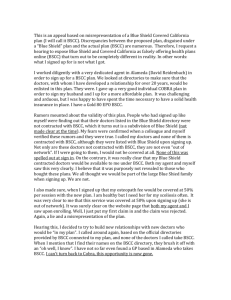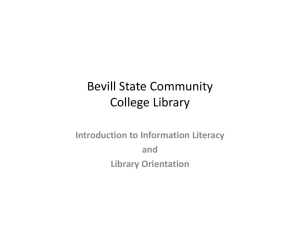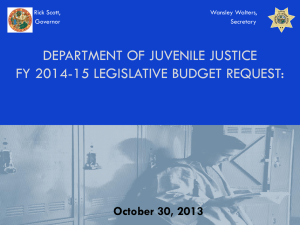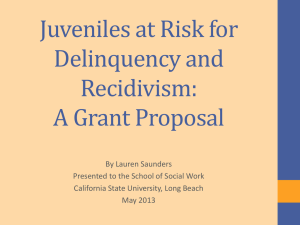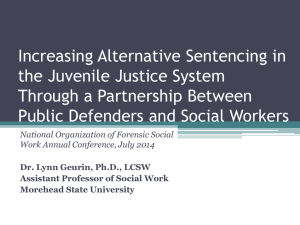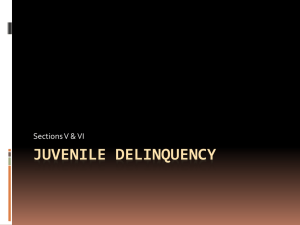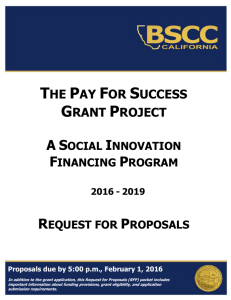Board of State and Community Corrections
advertisement
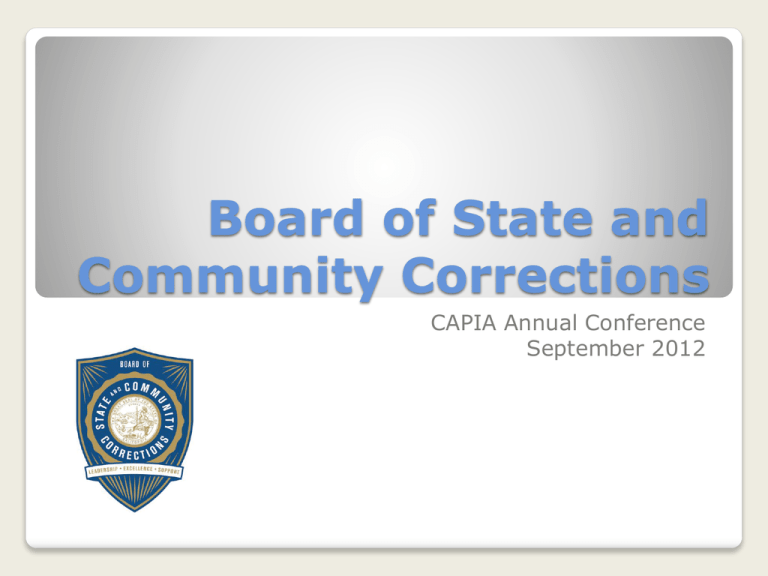
Board of State and Community Corrections CAPIA Annual Conference September 2012 Introductions CSA=>BSCC 2010-2012 Inspection Cycle Wrap Up JDPS Data Review MediCal and the Affordable Health Care Act Medical Issues in Juvenile Detention Facilities BSCC Topics ◦ Death in Custody ◦ Youth in Adult Court Holding: Probation’s Responsibility ◦ Juvenile Regulations Revision Agenda CSA BSCC “ . . . an agency is born . . .” On July 1, 2012, the CSA was abolished by SB 92 and the BSCC was born. Broad mandates: ◦ Provide statewide leadership, coordination and technical assistance. ◦ Promote effective state and local efforts and partnerships in California’s adult and juvenile criminal justice system, including addressing gang problems. ◦ Align fiscal policy and correctional practices, including prevention, intervention, suppression, supervision, and incapacitation. ◦ Data collection and reporting. CSA BSCC Consistent with Public Safety Realignment goals: ◦ Improving public safety through cost-effective, promising, and evidence-based strategies to manage statewide criminal and juvenile justice populations. CSA BSCC BSCC retains existing CSA duties ◦ ◦ ◦ ◦ Inspections & Regulations Grant disbursement Standards and Training for Corrections SB 81 Earned some NEW duties ◦ ◦ ◦ ◦ ◦ Focus on evidence based programs Data collection relative to realignment Gang suppression, intervention and prevention Collect and analyze CCP data Absorbed some CalEMA grants So what DOES the BSCC do? Creation of Juvenile Team ◦ Rebecca, Toni and Allison Dedicated resources So what DOES the BSCC do? 2010-2012 Inspection Cycle Wrap Up 2008-2010 Top Areas 1. 2. 3. 4. 5. 6. 1361 Grievance Procedure 1324 Policy and Procedures 1325 Fire and Life Safety 1371 Recreation & Exercise 1326 Security Review 1313 Local Inspection 1321 Staffing 8. 1354 Segregation 9. 1353 Orientation 10. 1358 Use of Restraints 11. 1372 Religious Program 12. 1357 Use of Force 7. 2010-2012 Top Areas of Concern Process not truly confidential Timeframes not listed or not reasonable ◦ Youth ◦ Concerns of parents Grievance and discipline ◦ Minor discipline ◦ Major discipline What you can do: Review policy AND procedures for discipline and grievance Review forms and placement ◦ Are they freely accessible? Are they truly confidential? Grievance Procedure Issues Annual review of manual ◦ Not documented, didn’t happen Policy doesn’t match procedure and vis versa What you can do: Formalize review Regular staff training Self inspections Policy and Procedures Issues Missing monthly inspections ◦ This is a self inspection and must be documented. There should be a corresponding checklist. Insufficient or Missing Fire Suppression PrePlan ◦ Should be a documentation of meeting with local fire authorities. ◦ Where to park the truck!! Lapse in drills What you can do: Work with local fire authority Establish safety committee to oversee inspections and plans Fire Safety Plan Issues Not being conducted/no documentation What you can do: Formalize process Security Review No posted schedule Not meeting regulatory times What you can do: Sit down with all staff (education, program, youth supervision) Recreation & Exercise Issues Missing Insufficient information Outstanding items of noncompliance ◦ Health Inspection issues will affect suitability What you can do: Remain in contact with department Get responses in writing Local Inspection Issues Meet staffing ratios, but… Units left unattended ◦ Youth on room confinement while others are out of the unit. ◦ Staff called off a unit to help with intake Required services denied due to insufficient staffing. ◦ Key symptom: “Well, it depends on staffing” as a response from youth and staff. Staffing Issues Is it ADMINISTRATIVE or DISCIPLINARY? ◦ Administrative segregation prior to disciplinary segregation ◦ Youth on administrative segregation not receiving normal privileges (except those related to the purpose of the segregation) ◦ Includes youth on separate program for classification purposes No review available ◦ What is the purpose of the review: to see if they can return to program or to extend them? Segregation Issues Missing recent Title 15 additions Agency can’t demonstrate that youth receive all the relevant information What you can do: Some alternative approaches: ◦ ◦ ◦ ◦ Dedicated orientation unit Dedicated orientation staff Checklist Quiz to reinforce most critical information Orientation Issues No clear reason for restraint Missing hourly reviews Checks—not actual documented observation of behavior Missing policy on pregnant minors What you can do: Well-designed form can guide staff through high anxiety situations Coordination & communication with medical and mental health staff ◦ Weekly MDT-Standing agenda item Use of Restraint Issues Youth on lock-down during religious programming Quality of “other program activities” offered to youth who choose not to participate Applies to any religious program, not just Sunday church service What you can do: Review/audit alternative programming Religious Program Issues No clear definition of force Lack of standardized reporting Lack of administrative review Not including policy for pregnant minors What you can do: Training Ongoing review of policy and procedure Ensure administrative review ◦ Team approach Use of Force Issues QUESTIONS? Juvenile Detention Profile Survey 7 Honored for Helping Crash Victims in Front of San Luis Obispo County Juvenile Hall Seven county employees received honors from the SLO County BOS for their swift action in helping people who were hurt in a traffic accident outside Juvenile Hall on Jan. 7. The board commended juvenile services officers Martin Meraz, Denise Dufrene, and Kyle Owens; correctional technician Amy King; supervising deputy probation officer Kyle Nancolas; physician’s assistant Pam Beaumont; and mental health therapist Jim Pearce. Sacramento Youth Detention Facility Receives National Award The Council of Juvenile Correctional Administrators (CJCA) announced that Sacramento County’s Probation Department was selected as the winner of a national award for extraordinary improvement to juvenile detention facility quality of life and operations by using performance-based standards (PbS). San Bernardino’s Gateway Program Earns National Honors On July 15, Gateway earned a national achievement award from the National Association of Counties. The recidivism rate for juveniles in the program is much lower compared to the state's re-offense rate. Recidivism is at 36.5% for the Probation Department in contrast to 80% for the state juvenile justice system. Dot Jones is nominated in the Outstanding Guest Actress In A Comedy Series category for her role as Coach Shannon Beiste on the FOX series "Glee." The Hilmar native transferred to Fresno State in 1984 after spending two years at Modesto Junior College. Hall She worked at the Fresno County Juvenile after graduating from college. 9636 10000 9000 8000 9246 8826 9046 7513 7475 7000 6000 9001 9068 8831 8614 8011 7273 7692 7757 7470 6698 7093 5000 6379 4000 6605 6019 3000 2000 1000 0 High Day 2002 2003 2004 2005 2006 2007 2008 2009 Bookings Ten year reductions 2010 2011 Juvenile Incarceration Rate and Median Income (2011) 82K-105K 2.33 61K-76K 2.93 Juvenile Incarceration Rate 45K - 59K 3.74 0 0.5 1 1.5 2 2.5 3 3.5 4 What does $$ have to do with it? COUNTY A COUNTY B Number of juveniles, ages 10 – 17: Median Income: Median Income: Juvenile Hall ADP: Juvenile Hall ADP: 31,007 $76,100 33.83 Number of juveniles, ages 10 – 17: 32,646 $73,300 100.41 You do the analysis! COUNTY A Number of bookings/month: 62.66 # of direct file bookings/month: 1.6 Probation Budget: $24 million Digging Deeper Number of bookings/month: 151.5 # of 777 bookings/month: 27.16 COUNTY B # of 777 bookings/month: 48.83 #of direct file bookings/month: 1 Probation Budget: $42 million What else would you want to know? Medi Cal and the Affordable Health Care Act Dr. Steven Rosenberg & Nancy Torrey Community Oriented Correctional Health Services (COCHS) Medical issues in juvenile detention facilities Dr. Carrick Adam Death In Custody What you need to know: Section 1341 Death & Serious Illness or Injury of a Minor Report to DOJ & BSCC Medical And Operational Review Deaths, Suicide Attempts, Suicide Prevention Notification Of The Juvenile Court And The Parent, Guardian Government Code Section 12525 ◦ DOJ - Statistics (916) 227-3545 ◦ BSCC – Written Statement Facts surrounding the case Section 1341 Purpose Medical And Operational Review Facility Administrator, Health Administrator, Responsible Physician, Health Care and Supervision Staff who are relevant to the incident Section 1341 QUESTIONS? Youth in Adult Court Holding Facilities: Probation’s Responsibility What you need to know: Is separation required? ◦ Adult Court Jurisdiction NO-JJDPA YES-State WIC ◦ Juvenile Court Jurisdiction YES-JJDPA & WIC Separation Requirements Sheriff’s Department is accountable and inspected for: ◦ Separation Including entrance and exit from holding areas. ◦ Safety Checks 30 minutes. ◦ Classification Plan Information about the youth’s risk of harm to self or others must be shared. Title 15 Requirements (Adult) Dry Cells? Food or snacks available? What has probation agreed to? Transportation? Other Areas of Consideration Written agreement between departments. ◦ Who is responsible for supervision of youth? Why Does Probation Care? QUESTIONS? Juvenile Regulations Revision 2011-2013 November, 2011 ◦ ESC met to review comments and provide direction to workgroups January-February 2012 ◦ Workgroups Met Administration Classification Programs Education Health Title 24 (Physical Plant) Revision Timeline April, 2012 ◦ Workgroup Chairs presented proposed regulations to ESC May, 2012 ◦ CSA Board approved proposed regulations Revision Timeline Some general clean up: ◦ Replacing “minor” with “youth” ◦ Change CSA to BSCC ◦ Some grammar geek stuff ◦ Develop “and implement” policy and procedure. Proposed Regulation Revisions Couple important new ones to amplify other regulations: ◦ Clergy (§1372) ◦ Exigent (§1321, Staffing) ◦ Gender expression, gender identity, sexual orientation, transgender youth(§1352) ◦ Non-school day (§1371) ◦ Separation (§1354) ◦ Special Visits (§1374) ◦ SB 81/construction related 1302, Definitions Revised definitions ◦ IEP ◦ Living unit Removed language about permanent barrier ◦ Psychotropic medication Deleted some ◦ Intensive supervision unit ◦ Licensed health care personnel Definitions, continued Strike out “asleep” and specify ratios when youth are “confined to their room for the purpose of sleeping.” Clarify that other staff, e.g., administration, supervision, etc., are not considered youth supervision staff. Defined exigent. Section 1321, Staffing Section 1324, Policy and Procedure Manual ◦ Biennial, as opposed to ANNUAL review. Section 1328, Safety Checks ◦ Clarifies safety checks while in holding cells and confined to bed in dormitory. ◦ Clarifies that checks are documented at the actual time the check is completed. P&P, Safety Checks NEW REGULATION! Intended for both custody and health staff— encouraging collaboration and cross training. Includes: ◦ Training ◦ Screening for suicide risk immediately upon confinement and prior to housing assignment. ◦ Provisions facilitating communication Guidance on housing of youth at risk of suicide. ◦ Adequate supervision depending on level of suicide risk. ◦ Suicide and suicide attempt intervention policies and procedures. ◦ Provisions for reporting suicides and suicide attempts. ◦ Critical incident debriefing. Section 1329, Suicide Prevention Program Section 1350, Admittance Procedures ◦ Halls shall have policy and procedure for advising committed youth of their estimated length of stay. Section 1352, Classification ◦ Provision that youth not be separated based solely on race, ethnic group identification, ancestry, national origin, color, religion, gender, sexual orientation, gender identity, gender expression, mental or physical disability, or HIV status. Admission and Classification Policy and procedure must address the reasons for separation: ◦ Medical and mental health conditions ◦ Assaultive behavior ◦ Disciplinary consequence ◦ Protective custody Daily review of separated youth New definition Section 1354, Separation Section 1357, Use of Force ◦ Add appropriate response if use of force is ineffective. Section 1358, Use of Physical Restraints ◦ Reordered to highlight priorities. Section 1360, Searches ◦ Searches shall, to the extent possible, be conducted in a manner that preserves the privacy and dignity of the person being searched. ◦ Develop policy and procedure for searching transgender youth. Use of Force, Restraint, Search Section 1361, Grievance Procedure ◦ Youth may grieve mistreatment, harassment, or violations of nondiscrimination policy Section 1378, Social Awareness Program ◦ Add tolerance and diversity. Section 1391, Discipline Process ◦ Clean up language ◦ Replace “penalties” with “consequences” ◦ Violations that result in camp removal, but not return to court, follow due process Grievance, Discipline, Programs Inspection of program completed by someone other than principal or school staff. Clean up of technical language. Ensure that movement time foes not interfere with minimum school time. Enrolled in school ASAP, no longer than 3 days. Section 1370, Education Program New name! Codify intent: ◦ To maximize the time youth are out of their rooms and not confined to their bed. Separate out three requirements: ◦ Recreation: one hour daily of unscheduled activities. ◦ Programs: social awareness programs as outlined in Section 1378 ◦ Exercise: one hour of large muscle exercise daily. Section 1371, Recreation, Programs, and Exercise Two year policy review Policy and procedure to address youth who may have special needs when using showers or dressing/undressing Intoxicated youth who are a threat to themselves or others Updates provisions for consent (SB 739) Preventative dental care; annual dental exams if in the facility more than a year Lowered caloric intakes; added guidance for sodium Shaving: males-daily, females-legs and underarms weekly Health, Nutrition and Environmental Heath Revisions Deleted intensive supervision units Title 24, Physical Plant Revisions PREA Working Group (?) LGBT Working Group ◦ To develop white paper/proposed regulations Post Disposition Commitment ◦ Working group to go over issues and identify any solutions Other Action Open public comment period ◦ 45 days long ◦ Two public hearings: One in Southern California One in Northern New Title 15 final early next year Title 24 later in 2013 NEXT STEPS You all made the regulations revisions a HUGE success. THANK YOU!! Wrap up Sign sheet for e-mail copies of documents Allison Ganter, Field Representative 916.323.8617 allison.ganter@bscc.ca.gov Toni Gardner, Field Representative 916.322.1638 toni.gardner@bscc.ca.gov Rebecca Craig, Field Representative 916.324.2600 Rebecca.craig@bscc.ca.gov Any questions?





